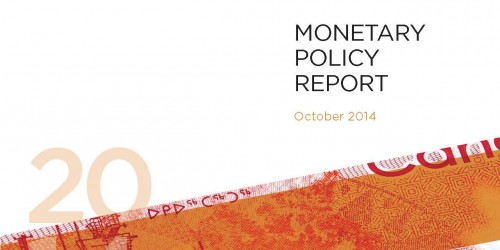Release of the Monetary Policy Report
Good morning. Carolyn and I are pleased to be here with you today to discuss the October Monetary Policy Report (MPR), which the Bank published this morning.
As I’ve said in the past, the policy decision is not a mechanical one, so I’d like to provide some colour around the issues we are dealing with. I would also like to highlight some advances in our thinking since the last MPR.
Our outlook for the global economy continues to show stronger momentum in 2015 and 2016, but the profile has been downgraded since July. The good news for Canada is that the U.S. economy is gaining traction, particularly in sectors that are beneficial to Canada’s exports.
And our exports do appear to be responding, with some additional help from a lower Canadian dollar. Our conversations with exporters indicate that they are seeing a better export outlook from the ground.
However, it is clear that our export sector is less robust than in previous cycles. Last spring, as you may recall, we identified which non-energy subsectors could be expected to lead the recovery in exports, and which would not.
We have since investigated in more detail the subsectors that have been underperforming. After sifting through more than 2,000 product categories, we have found that the value of exports from about a quarter of them has fallen by more than 75 per cent since the year 2000. Had the exports of these products instead risen in line with foreign demand, they would have contributed about $30 billion in additional exports last year.
By correlating these findings with media reports, we could see that many were affected by factory closures or other restructurings. In other words, capacity in these subsectors has simply disappeared. This analysis helps us understand a significant portion of the gap in export performance.
Our research also tells us that most of the sectors expected to lead the non-energy export recovery still have some excess capacity. Our Business Outlook Survey (BOS) interviews indicate that while companies plan to invest in new machinery and equipment, few are planning to expand their capacity, at least so far. This helps explain why business investment might be delayed relative to what would be expected in a normal cycle.
This research has important implications for Canada’s employment picture. We know that when companies restructure or close their doors, the associated job losses are usually permanent. If companies can meet increased export demand with existing capacity, the associated employment gains can be fairly modest, with most of the increase in output coming in the form of higher productivity. The bigger employment gains will come when we enter the rebuilding phase of the cycle - when companies are sufficiently confident about future export demand that they begin to invest in new capacity and create new jobs.
These considerations enter into our estimation of the output gap - the difference between GDP and potential GDP - which is the key macroeconomic determinant of the outlook for underlying inflation. When the economy is operating with excess supply, inflation declines, and when operating with excess demand, inflation rises.
There is no single preferred measure of excess supply in the economy. Traditionally, we have put the most weight on measures based on output, or GDP. Each October, we do a full analysis of the determinants of potential output, and its future trend. We have done so in this MPR, but in future we will do this in every MPR. This time, we also offer a special technical box that considers the dynamics of excess capacity in longer business cycles like this one.
The reason this is important is that in such longer business cycles, the restructuring or closure of firms reduces potential output while creating permanent job losses. This means that the output gap can appear smaller than the labour market gap, which is our current situation. This difference persists until the rebuilding phase of the recovery I discussed earlier, after which the excess capacity measures eventually converge.
Our judgment is that we have considerable excess capacity and that continued monetary stimulus is needed to close the gap and bring inflation sustainably to target. But we take account of our uncertainty around the degree of slack by considering a range of possible slack estimates in our deliberations.
Another important building block of our policy framework is the neutral rate of interest. Carolyn discussed this in an important speech last month; there is also a discussion paper about it, and a box in this MPR. The neutral rate, too, is uncertain. We estimate that it now lies between 3 and 4 per cent, which is well below pre-crisis levels. But since the difference between current rates and the neutral rate is our best estimate of monetary stimulus, understanding the risks around this is also important.
After weighing these considerations, it is our judgment at this time that the risks around achieving our inflation objective over a reasonable time frame are roughly balanced. Accordingly, we believe that the current level of monetary stimulus remains appropriate.
Some of you may be wondering why we aren’t being more specific about the likely future stance of monetary policy. Let me answer by saying that forward guidance remains a key element of the policy tool kit - but one that we will reserve for times when we believe there are net benefits to its use. There will no doubt come a day when we will offer forward guidance again - but not this day.
And with that, Carolyn and I would be pleased to answer your questions.
